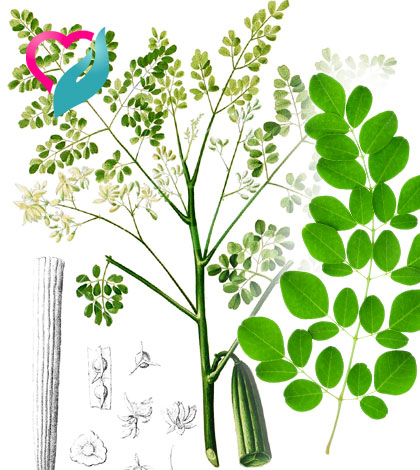Let us introduce this strange-sounding plant to you in a familiar term – drumstick tree. As you know now that it is an edible plant native to Asia and Africa but cultivated around the world. Do you know that it has an impressive range of medicinal uses with high nutritional value? In fact, the Moringa tree’s benefits are so significant that it has been called the “Tree of Life” in many cultures.
[wp_ad_camp_1]
The plant possesses horseradish-like root and hence known to the western world as horseradish tree. The seed pods are popular as murnga in Tamil, and malunggay in Filipino.
The young, immature Moringa Oleifera pods are the most valued and widely used of all the tree parts. The pods are extremely nutritious, containing essential amino acids, forming a complete protein source, and many vitamins, minerals, co-enzymes, and antioxidants.
[wp_ad_camp_4]
Inch-by-inch this “miracle tree” is packed with more nutrition than any other plant in the world. Just look at how many more nutrients dried Moringa leaves contain compared to these other foods:
- 4 times the Vitamin A of Carrots
- 7 times the Vitamin C of Oranges
- 4 times the Calcium of Milk
- 3 times the Potassium of Bananas
- 3 times more Iron than in Almonds
- 3 times more Vitamin E than in Spinach
- 2times the Protein of Yogurt
[wp_ad_camp_2]
Moringa – A Complete Food
Moringa Oleifera contains more than 92 nutrients and 46 types of antioxidants. Moringa is said to cure about 300 diseases and have almost all the vitamins found in fruits and vegetables in larger proportions. With all the health benefits of this miracle herb, it can easily be termed as the most nutritious herb on Earth. It has been tried, tested, documented and proved that there are no side-effects. It can be consumed by small children and adults. Today, millions world over have started using Moringa based products in porridge, pastas, bread, etc., to experience the everlasting health benefits of this extraordinary herb.
- 92 Nutrients
- 46 Antioxidants
- 36 Anti-inflammatories
- 18 Amino acids, 9 essential amino acids
- Nourishes the immune system
- Promotes healthy circulation
- Supports normal glucose levels
- Natural anti-aging benefits
- Promotes healthy digestion
- Promotes heightened mental clarity
- Boosts energy without caffeine
- Encourages balanced metabolism
The Store House of Vitamins
Moringa has Vitamin A (Beta Carotene), Vitamin B1 (Thiamine), Vitamin B2 (Riboflavin), Vitamin B3 (Niacin), Vitamin B6 Pyrodixine), Vitamin B7 (Biotin), Vitamin C (Ascorbic Acid), Vitamin D (Cholecalciferol), Vitamin E (Tocopherol) and Vitamin K.
Amino Acids: The Building Blocks
Human body needs twenty different amino acids or proteins to build and maintain health. Nonessential amino acids are those that the body can synthesize for itself, provided there is enough nitrogen, carbon, hydrogen, and oxygen available. Essential amino acids are those supplied by the diet. They must be consumed as the human body either cannot make them at all or cannot make them in sufficient quantity to meet its needs. Of the 20 amino acids required by our bodies, eleven of them are nonessential and nine are essential.
If these critical components for a healthy body are not provided as part of a healthy diet, the body will look for other sources to extract them. This can include breakdown of our organs, leading to chronic problems such as liver and kidney problems, diabetes and heart disease among others.
Benefits of Moringa Oleifera
Here are just a few of the many real benefits people discover when taking this amazing product.
1. Increased Energy – Enhances body’s energy and alertness.
2. Mental and Emotional Balance – Powerful nutrient compounds help restore stability to the chemicals that govern our thoughts and emotions. You have to experience it to appreciate it!
3. Recovery Food – Moringa Oleifera’s complete amino profile, along with dozens of vitamins and minerals, makes it a perfect recovery food after grueling workouts and physical strain.
4. Nutrient-Dense Mother’s Milk – Increased iron, potassium, Vitamins A, B, C, E, and dozens of other important nutrients are all readily absorbed from Moringa Oleifera and transferred from mother’s milk to the growing newborn. No wonder it is called “mother’s best friend” in cultures across Africa.
5. Healthy Blood Sugar Level – antioxidants and unique regulating compounds help control blood sugar and keep the blood free of unhealthy substances
6. Ear Doctor – Juice of Moringa leaves mixed with sesame oil and rock salt, slightly warmed, filled into ears is an effective home-remedy for earache.
7. Gastric Healer – A teaspoon of drumstick-leaf juice mixed with honey and coconut water will help to prevent digestive problems such as diarrhea, dysentery, colitis, jaundice, and cholera.
8. Pimple Buster – Fresh drumstick-leaf juice can be mixed with lime juice to help prevent acne, pimples, and blackheads
9. Never-Ending Benefits – Just a few of the other many benefits of Moringa Oleifera include increased flexibility, improved sensory perception, better sleep cycles, decreased depression and anxiety, and improved memory. It has been used to help those with diabetes, arthritis, high blood pressure, and even cancer. It is also used to combat malnutrition, especially among infants and nursing mothers.
Selection and Storage
Fresh Moringa pods and greens are readily available in markets all around the season in the tropical and sub-tropical countries of South-East Asia, Philippines, Middle-Eastern, Africa, Caribbean, and in some Central American region. In the USA, the tree grows easily in the Southern states; however, only few owners grow them in their backyard. Its consumption in the USA is mainly driven by several thousand expatriated communities of Asian and African background, who prefer the plant parts in their diet.
While buying fresh pods look for just tender, uniform, evenly filled, green color pods. Avoid dry, shriveled, bent, twisted, or broken pods. Do not buy over-mature big-sized pods as they feature tougher skin, bitter pulp and hard seeds and thus unappetizing.
At home, pods can keep well for 1-2 days at room temperature, however, should be kept in the refrigerator for extended shelf life.
Preparation and Serving Methods
Fresh leaves and tender seedpods are used extensively in Asian, African and Caribbean cuisine. Only tender growing tips and young leaves are generally used in cooking. However, mature leaves are dried, powdered and can be stored for longer periods to be used in the recipes.
Wash the greens in cold water as you do in case of other greens like spinach. To prepare fresh pods, clean them in cold water and mop dry using an absorbent paper towel. Trim the ends. Cut the pod at one to two inches intervals and use in soups, curries, etc. Clean the leaves as you do for other greens. Sift the leaves from the twig and discard the stem. Chop the leaves if you wish, or whole leaves can be used in the recipes.
However you serve it and eat it, Moringa is a powerhouse of health and we all should strictly include it in our daily diet. Do you hear AR Rahman singing “mo-Ringa mo-Ringa….
[wp_ad_camp_3]
Image courtesy: wikimedia.org , earthdoctor.com ,











